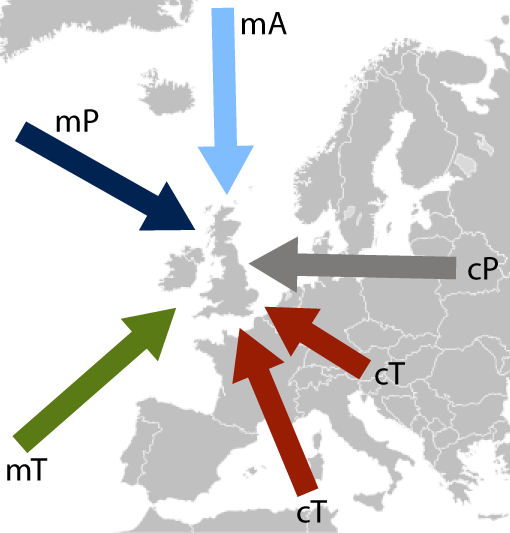Air masses

Figure 4: A schematic depiction of five principal air mass types that affect the British Isles: mA = maritime Arctic; mP = maritime Polar; mT = maritime Tropical; cT = continental Tropical; cP = continental Polar. By E. Graham (2014) after Belasco (1952).
An air mass may be defined as a large body of air whose physical properties of temperature, moisture content and lapse rate are fairly uniform over a broad region of hundreds of kilometres or more in size (Barry and Chorley, 2009). The type of air mass that is generated depends on the surface landscape, time of year, latitude, albedo, moisture availability, as well as the prevailing weather conditions (over an ocean, the air mass type that is created simply depends on the sea surface temperature and the size of the sea area). Over large homogenous regions of the Earth, such as near the centre of large continents (e.g. Siberia, Northern Canada, the Amazon basin) or over the seas and oceans (e.g. the sub-tropical Atlantic, the Gulf of Mexico), large areas of similar weather (defined in terms of air temperature, moisture content and lapse rate) may develop during their respective seasons – these then become the source region of an air mass.
In the case of Europe, several different air mass types can be readily identified, depending on the time of year (see Figure 4; Belasco, 1952; Sweeney & O’Hare, 1992). These principal five air masses are depicted in Figure 1 and also summarised in Table 1. Together, these air masses account for most of the different weather conditions experienced across the British Isles throughout the year, although the frequency of Maritime Tropical (mT) and Maritime Polar (mP) air masses is considerably greater than Maritime Arctic (mA), Continental Tropical (cT) or Continental Polar (cP). It is the interaction between these different air masses that cause most of the weather systems, such as fronts and depressions.
Table 1
| Air Mass Name | Abbr. | Origin of Air Mass | Winter conditions | Summer conditions |
|---|---|---|---|---|
| Maritime Tropical | mT | Between Bermuda and the Azores in the North Atlantic Ocean | Dull, windy, mild, rain | Dull, rain in west, warm on leeward slopes |
| Maritime Polar | mP | Between the Davis Strait, Labrador and Greenland (but modified considerably after passing over Atlantic) | Cold, windy, showery | Cool, blustery, showery. Bright in-between showers. |
| Maritime Arctic | mA | Between Iceland, Svalbard and Norway | Crisp, wintry showers, frost at night | Cool, bright, heavy showers |
| Continental Polar | cP | Eastern Europe, Russia and rarely Siberia (but modified after passage over the North Sea). | Bitterly cold, snow showers on east-facing coasts and slopes | Doesn’t occur in summer |
| Continental Tropical | cT | North Africa and the European continent | Rarely occurs in winter (only from North Africa) | Warm, mostly sunny, possible heat-wave |
Table 1: Five of the principal air mass types that affect the British Isles during the year (after Belasco, 1952). The name, abbreviation, origin of air mass and typical summer and winter conditions (for the British Isles) are given.